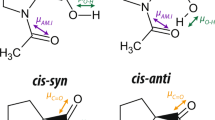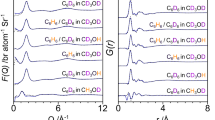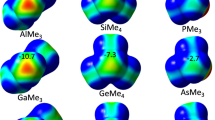Abstract
Millen and Zabicky1 have recently reported the infrared detection of hydrogen bonding in gaseous mixtures of methanol and methylamines. The strongest complex appears to be formed with trimethylamine, and the OH stretching band, displaced to 3,350 cm−1, shows pronounced shoulders at 3,495 cm−1 and 3,200 cm−1. These have been interpreted by Millen and Zabicky as the sum and difference combinations of 3,350 cm−1 with the stretching of the H-bond itself, implying a frequency for the latter of about 140 cm−1. An alternative explanation of the shoulder on the high-frequency side is that it is due to a weak band associated with the trimethylamine part of the complex, intensified by Fermi resonance with the 3,350 cm−1 band. At Dr. Millen's suggestion we have examined the far infra-red absorption of gaseous methanol–amine mixtures, in an attempt to distinguish between these two possibilities.
This is a preview of subscription content, access via your institution
Access options
Subscribe to this journal
Receive 51 print issues and online access
$199.00 per year
only $3.90 per issue
Buy this article
- Purchase on Springer Link
- Instant access to full article PDF
Prices may be subject to local taxes which are calculated during checkout
Similar content being viewed by others
References
Millen, D. J., and Zabicky, J., Nature, 196, 890 (1962).
Author information
Authors and Affiliations
Rights and permissions
About this article
Cite this article
GINN, S., WOOD, J. Hydrogen Bonding in Gaseous Mixtures: Amine–Alcohol Systems. Nature 200, 467–468 (1963). https://doi.org/10.1038/200467b0
Issue Date:
DOI: https://doi.org/10.1038/200467b0
This article is cited by
Comments
By submitting a comment you agree to abide by our Terms and Community Guidelines. If you find something abusive or that does not comply with our terms or guidelines please flag it as inappropriate.



